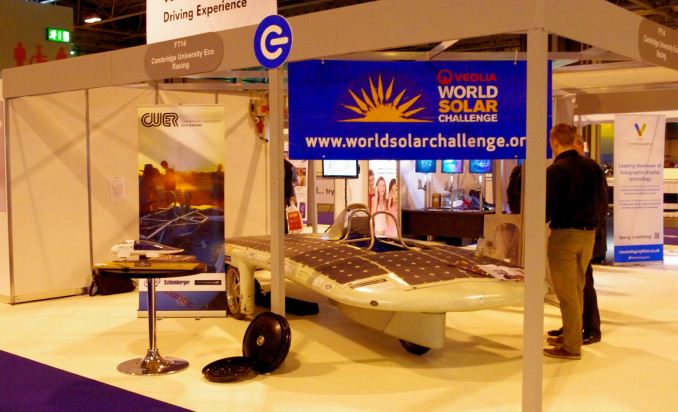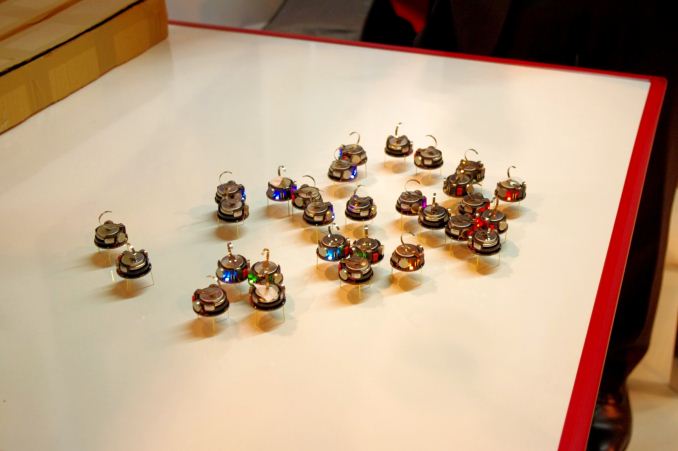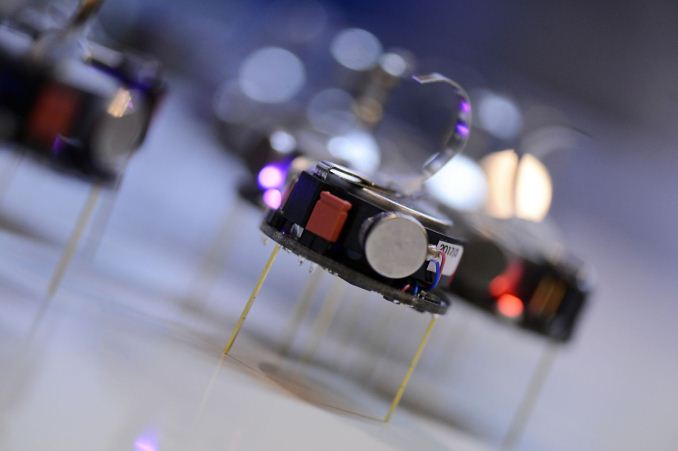The Gadget Show Live, April 2013: Technology in the UK
by Ian Cutress on April 4, 2013 6:30 AM EST- Posted in
- Trade Shows
- UK
- Gadget Show
Cambridge University Eco Racing: Solar Challenge 2013
For those unfamiliar with the Solar Challenge, it is a 3000 mile biennial ‘race’ across the Australian desert with two main goals – fuel efficiency and speed. By using as little initial energy as possible, the Solar Challenge pits energy efficient vehicles against each other to see how fast they can transverse this epic course. One such team is from Cambridge University, present at the Gadget Show Live in order to promote not only themselves but also the event, to investors and the media.
Clearly with the race being in Australia and in the desert, all teams use solar panels. The current CUER design has competed in the past two challenges, and all the entrants have looked very similar – the race in 2013 has had a significant set of rule changes (such as 4 wheels rather than 3), and as such new vehicles have to be designed. All vehicles in the race must have a driver rather than an automated GPS system, and by using student power (which comes very cheap!), the CUER team explained the technology behind their vehicle for the upcoming event.
I have some knowledge of solar cells, as it was a close cousin of my general academic area at university. At the time of those lectures, solar cells were being touted at around 20-25% efficiency; currently the ones being used by CUER are up to 35.5%, which is astonishing for only a few years research. These are expensive, made with space-grade Gallium Arsenide, and might not be the lightest available, but they sure are efficient. In order to save weight elsewhere, we have a carbon fiber monocoque weighing only 30 kilograms but measuring 4.5m x 0.8m.
With the heat in the outback, you obviously need to cool both the components and the driver. The team use 14cm Noctua NF-A14 FLX fans underneath the solar panels, as they provide the best CFM for the lowest power - ~30 CFM for 0.8 W. The solar panels in the new design tilt themselves with the direction of the sun depending on the direction the vehicle is pointing and the time of day; luckily the challenge is typically very dry with low humidity, but on public roads so there is the challenge of a cattle grid or two. CUER is aiming for a vehicle that will hit a top speed of 140 km/h, weight under 120 kg, and complete the course in less than 30 hours.
Website link: http://www.cuer.co.uk
Swarm Robotics: Developing Pack Behavior
The field of Robotics is undoubtedly large and ever expanding. Much of the news we see is about human-like robots and interactions, and how these devices fit into our modern world such that the real life won’t jump back in horror. The other end of the scale is miniaturization, and understanding how a large number of elements in a system (ants in a nest, bees in a hive) can co-operate together to achieve a bigger task or decide what to do as part of a group. Things like finding the best trail to a sugar source and telling everyone else, or bunching together to build a new version of yourself are part of this field, and the Sheffield University group of Dr Roderich Groß was at Gadget Show Live, after being showcased on The Gadget Show media network.
Clearly little robots are interesting, and getting them to decide as a group the best way from A to B, without any interaction, is all about detecting local environment. The first port of call would be computer simulation, but nothing gets the creative juices flowing like a hands-on demonstration. Using e-Pucks and Kilobots, the robots talk to each other via infra red using sensors to determine their local environment and perform the task. Each robot has a localized memory (the smaller the robot, the smaller the memory – in the case of the Kilobots, 32-64 kilobytes), which stores basic commands and an element of ‘swarm memory’. They can be globally controlled for simple commands via infra-red, either by a sensor array (Kilobots) or a programmed remote control (e-Pucks).
The research team are helping program the robots to perform swarm and global activities that have worked well in simulation – special aggregation and segregation into strata (combining then organizing into layers, much like shaking a bowl of nuts the brazils always rise to the top), cooperative transport, and self assembly. Ultimately the goal is replication, such that when being provided with the modular building blocks whether as a swarm the robots will be able to recreate new copies or even modified copies based on the needs of the collective. It works in simulation, but experiment is a different matter entirely.
Once this works on the ‘large’ scale (the kilobots are roughly the diameter of a quarter), the aim is miniaturization. Obviously that has many hurdles in itself, in terms of power, response, memory and application. One application demonstrated is of bringing ‘food’ from a source to a nest; now a marketable goal would be if automated robots could divide and conquer the detection and removal of weeds from a field in agriculture, or help in medical research.
With the collective research funding from national and European sources continually diminishing, researchers and research groups are often looking at other sources of funding for industry – the main barrier to this is working towards a marketable product which may not be readily apparent at the start. The latest research grant awarded to Dr Groß’s research group is one from of the national bodies, to expand on the idea of self assembly. The problem is that this field has many more ideas than there are people and money to go around – so almost any source of funding is welcome.
Incidentally, if any undergraduates or postgraduates are interested in this field and pursuing academia, there are a number of positions available on the research website.















24 Comments
View All Comments
jabber - Thursday, April 4, 2013 - link
The Gadget Show??? I must admit I don't know anyone that watches that show anymore. It was okay originally when they group tested the latest cameras and deep fat fryers but now it's all stupidly expensive Arab prince playthings. It comes to something when the cheapest stuff they show are Apple products. A reality disconnect. Oh and the presenters are dicks too.hughlle - Thursday, April 4, 2013 - link
Have to agree. It's in the name. Gadget. An igloo 360 degree gaming experience does not really fal into the notion of a gadget for me, considering the level of sophistication, let alone the size of the thing.IanCutress - Thursday, April 4, 2013 - link
There are two different markets for gadgets - the consumer or the business. Now I can't imagine an individual having a 360 gaming experience in the home unless they have the space and the cash, but there is scope for businesses to hire them for events, or use them as marketing tools to build new clients. In that sense, they are very much a gadget from my POV.Also the 'Live' show floor has very little to do with the OTA TV programme, except in name and advertising. There are corollaries between items featured in the TV Show and the event, mostly by virtue that the company making the product wants to advertise it to the event audience. Not once did I see or bump into any of the Gadget Show presenters.
The TV broadcast doesn't specialise in any real field; their market is the non-enthusiast. As such, the non-enthusiast may not appreciate being told the difference between 18 different smartphones or laptops, only one or two, and they don't really care about the motherboard as they buy systems prebuilt. And in much the same way that Top Gear doesn't really review anything for regular people, TGS veers into that high end space more often than not in order to show 'here's something in the high end space''.
Ian
Modjo30 - Friday, April 5, 2013 - link
Guess you don't watch it ever then because they are always testing the cheaper items, they were testing the latest touch screen camera's on the latest episode, costing £199 and £299, i wouldn't call that arab prince playthings really, However it is a bit like Top gear, an awful lot of people are interested in seeing these amazing gadgets and what peoples minds have thought up, you go back to your farm and your armish lifestylecjs150 - Friday, April 5, 2013 - link
The presenters are not dicks, they are too juvenile for their balls to have dropped yet.It is a show made by 9 year old boys for 9 year old boys (but with a pretty women as one of the presenters in case the 9 year old's elder brother (13) ends up watching it). Shame because some of the tech is truly interesting.
takuan2uk - Saturday, April 6, 2013 - link
Hi, I used to be a Gadget Show fan as well, but it has long ceased to be a show aimed at techies and gadget freaks. As is common with many programs it has dumbed down and become more sensationalised so as to appeal to a wider audience. You can tell that they're milking it for all it's worth when they sent one of the presenters to Italy just to test out some (rather ordinary) headphones!AncientWisdom - Thursday, April 4, 2013 - link
Great write up, definitely some interesting ideas and gadgets presented.very interested in a follow-up of the Gunnar products as well as the group robot stuff which I find very stimulating intelligently speaking.
NobleKain - Monday, April 8, 2013 - link
AncientWisdom ~Following this write-up, I went and bought a pair of the Gunnar's (Wi-Five model). I love them! My assumption is that since I have a FSA (health savings account) that I haven't yet touched, I can probably get them reimburesed given their purpose (Note: I have not yet attempted reimbursement, so don't trust that it is possible... I just assume it is).
Anyway, I have had my pair since last Friday (4/5/13). I absolutely love them. I'm a comp programmer, so I spend 8+ hours a day in front of my PC, followed by an evening of reading on my iPad mini. They make a HUGE difference, but you should note: it takes awhile to get used to them (it took me a little over an hour). While the magnification is minor, it's enough to "weird" out your eyes. I presume this is because your eyes are used to working harder. Whatever the reason, it takes a bit to get comfortable with them, but after the hour, I can now wear them without issue. Also, I no longer need a "warm-up" to them. They simply work comfortably.
Another caveat; the magnification REDUCES the clarity of anything more than 10ft. away. Again, this is very, very minor, but it is worth noting. These won't be all-day replacements for all activities. These are single-purpose glasses, IMO... looking at computer screens.
I got the yellow'd tinted versions, and I'd suggest you do the same, unless you NEED the clear versions.
Anyway, as a customer, I'm very happy with my purchase - and if I'm correct that I can use my FSA funds, I'll be even happier. Either way, it's worth it (I paid $106 after tax). I'm tempted now to get a pair for home, so I don't have to bring these ones back and forth.
dylan522p - Thursday, April 4, 2013 - link
Great write up, but I feel like the gadget show is not about gadgets.jabber - Thursday, April 4, 2013 - link
We used to go to the Stuff show at the end of the year. Then the next day we visited Selfridge's home entertainment and computer dept. We found 95% of the gear on show at the Stuff show in there...and it didn't cost anything to go in.Suffice to say we don't bother paying/visiting that many gadget/tech shows these days.